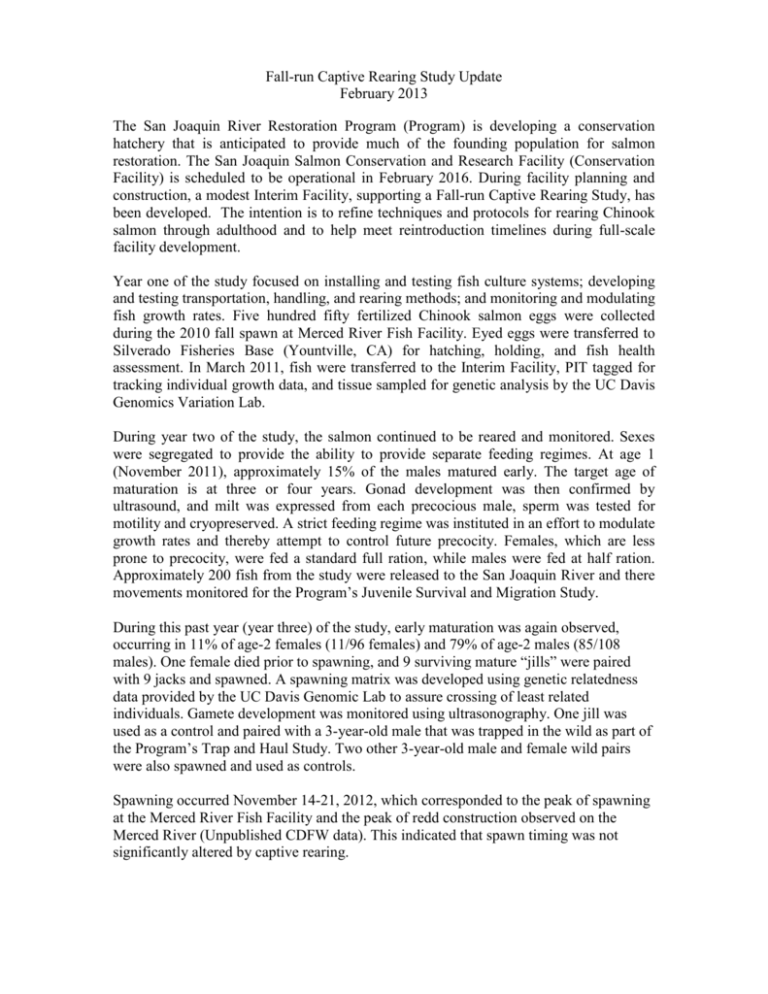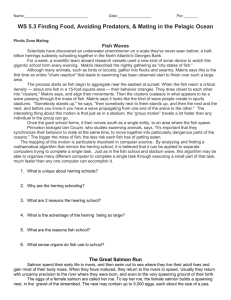Summary - Restore San Joaquin
advertisement

Fall-run Captive Rearing Study Update February 2013 The San Joaquin River Restoration Program (Program) is developing a conservation hatchery that is anticipated to provide much of the founding population for salmon restoration. The San Joaquin Salmon Conservation and Research Facility (Conservation Facility) is scheduled to be operational in February 2016. During facility planning and construction, a modest Interim Facility, supporting a Fall-run Captive Rearing Study, has been developed. The intention is to refine techniques and protocols for rearing Chinook salmon through adulthood and to help meet reintroduction timelines during full-scale facility development. Year one of the study focused on installing and testing fish culture systems; developing and testing transportation, handling, and rearing methods; and monitoring and modulating fish growth rates. Five hundred fifty fertilized Chinook salmon eggs were collected during the 2010 fall spawn at Merced River Fish Facility. Eyed eggs were transferred to Silverado Fisheries Base (Yountville, CA) for hatching, holding, and fish health assessment. In March 2011, fish were transferred to the Interim Facility, PIT tagged for tracking individual growth data, and tissue sampled for genetic analysis by the UC Davis Genomics Variation Lab. During year two of the study, the salmon continued to be reared and monitored. Sexes were segregated to provide the ability to provide separate feeding regimes. At age 1 (November 2011), approximately 15% of the males matured early. The target age of maturation is at three or four years. Gonad development was then confirmed by ultrasound, and milt was expressed from each precocious male, sperm was tested for motility and cryopreserved. A strict feeding regime was instituted in an effort to modulate growth rates and thereby attempt to control future precocity. Females, which are less prone to precocity, were fed a standard full ration, while males were fed at half ration. Approximately 200 fish from the study were released to the San Joaquin River and there movements monitored for the Program’s Juvenile Survival and Migration Study. During this past year (year three) of the study, early maturation was again observed, occurring in 11% of age-2 females (11/96 females) and 79% of age-2 males (85/108 males). One female died prior to spawning, and 9 surviving mature “jills” were paired with 9 jacks and spawned. A spawning matrix was developed using genetic relatedness data provided by the UC Davis Genomic Lab to assure crossing of least related individuals. Gamete development was monitored using ultrasonography. One jill was used as a control and paired with a 3-year-old male that was trapped in the wild as part of the Program’s Trap and Haul Study. Two other 3-year-old male and female wild pairs were also spawned and used as controls. Spawning occurred November 14-21, 2012, which corresponded to the peak of spawning at the Merced River Fish Facility and the peak of redd construction observed on the Merced River (Unpublished CDFW data). This indicated that spawn timing was not significantly altered by captive rearing. Early maturation and captive rearing limited the size of fish at the spawning stage, when compared with spawned wild control fish. Growth rates of male fish had been intentionally slowed in an effort to reduce levels of precocity. Therefore, males were considerably smaller than two-year-old wild counterparts. Female growth rates were not restricted, yet they also were smaller than their wild counterparts, averaging approximately 1.5 lbs at time of spawning. The smaller size of captive reared salmon is common in similar programs. The body size of female salmon at time of spawning is correlated with fecundity. As anticipated, fecundity was low, averaging 1066 eggs per female (N=10), and egg size was small, averaging 185 eggs/fluid oz (Table 1). Comparatively, fecundity from the two female wild controls averaged 6,495 eggs with an egg size averaging 85 eggs/fluid oz. Fertility and early survival of eggs obtained from study fish was relatively high. Egg survival to the eyed stage averaged 87% for study fish and approximately 90% for the two female wild control salmon. However, survival was significantly lower for the study fish during hatch and through swim-up. Many sac fry died while emerging from shells, which resulted in a 28 percent survival to swim-up. The lower survival of eggs from study fish was likely due to the small egg size and low nutritional status of the fry. Reduced survival of eggs from two-year-old female Chinook has also been reported from wild Chinook returning to the Merced River Hatchery, albeit less severe than observed in this study. The Fall-run Captive Rearing Study continues to be a valuable tool in preparing for rearing spring-run Chinook for the Program. The study continues to highlight challenges associated with captive rearing and is assisting in developing the required infrastructure and tools for successful captive rearing. The data obtained from the study will continue to direct research and refine captive rearing techniques. Table 1. Spawning Data from the 2012/13 Fall-run Captive Rearing Study Age-2 captive reared female fall-run Chinook salmon (N=10) Average fecundity Average number of eggs per liquid oz Average survival to eyed egg stage Average survival from eyed stage to swim-up 1,066 185 87% 28% Age-3 fall-run Chinook salmon rescued from San Joaquin River (N=2) Average fecundity Average number of eggs per oz from SJR trapped females Average survival to eyed egg stage Estimated average survival from eyed stage to swim-up (swim-up in progress) 2 6,406 86 90.5% > 90% 3







